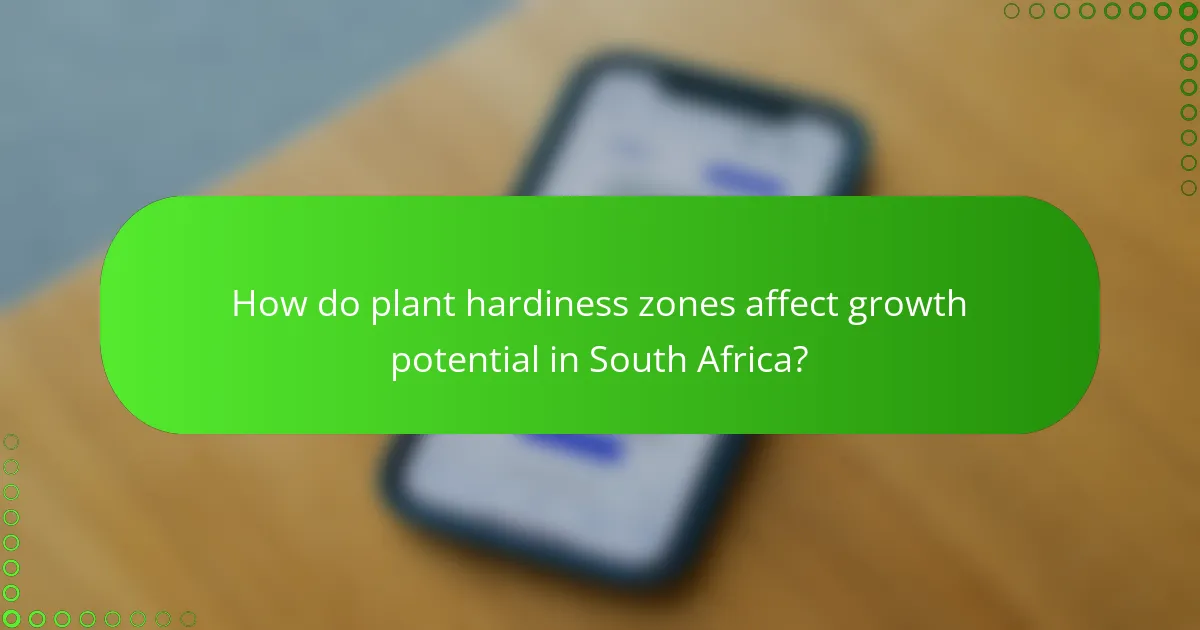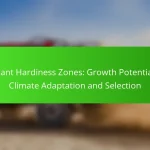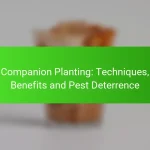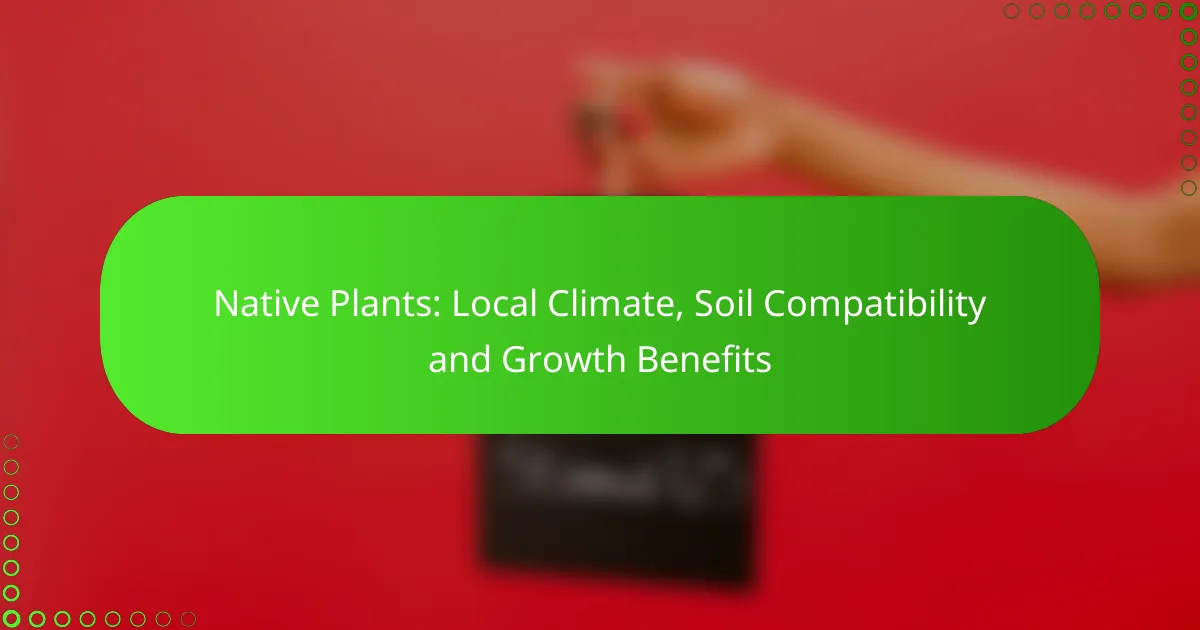Plant hardiness zones play a crucial role in determining the growth potential of various species by aligning them with specific climatic conditions. In South Africa, these zones guide gardeners and farmers in selecting plants that are best suited for their local environment, taking into account factors such as temperature extremes and seasonal variations. By understanding these zones, individuals can make informed choices that enhance plant survival and overall garden success.

How do plant hardiness zones affect growth potential in South Africa?
Plant hardiness zones significantly influence growth potential in South Africa by determining which plants can thrive in specific climatic conditions. These zones, based on minimum temperature ranges, help gardeners and farmers select appropriate species that are more likely to succeed in their local environment.
Understanding growth potential
Growth potential refers to the ability of a plant to develop and flourish based on its hardiness zone. In South Africa, the hardiness zones range from 8 to 11, indicating varying temperature tolerances. For instance, plants suited for zone 9 can withstand minimum temperatures of around 20°C, making them ideal for warmer regions.
When selecting plants, consider their growth habits, water needs, and susceptibility to pests and diseases. For example, indigenous plants often have a higher growth potential in their native zones due to their adaptation to local conditions.
Impact of climate on plant selection
Climate plays a crucial role in plant selection, as it affects not only temperature but also rainfall patterns and humidity levels. In South Africa, regions with higher rainfall may support more moisture-loving species, while arid areas require drought-resistant plants. Understanding these climatic factors is essential for successful gardening and farming.
When choosing plants, assess the local climate and consider factors such as soil type and exposure to sunlight. For example, succulents thrive in dry, sunny areas, while ferns prefer shaded, moist environments. Selecting plants that match the local climate will enhance growth potential and reduce maintenance efforts.

What are the plant hardiness zones in South Africa?
Plant hardiness zones in South Africa categorize regions based on climate conditions, particularly temperature, to guide gardeners and farmers in selecting suitable plants. These zones help determine which plants will thrive in specific areas, considering factors like frost and heat tolerance.
Zone classifications
South Africa’s plant hardiness zones are classified into several categories, ranging from Zone 1, which is the coldest, to Zone 13, the warmest. The most common zones in South Africa include Zones 5 to 10, with variations depending on local microclimates. Understanding these classifications allows for better plant selection aligned with regional climates.
Temperature ranges for each zone
Each hardiness zone in South Africa corresponds to specific temperature ranges, which influence plant growth. For instance, Zone 5 typically experiences minimum temperatures between -15°C to -10°C, while Zone 10 has minimums around 0°C to 5°C. These ranges are crucial for determining the types of plants that can survive and flourish in each zone.
When choosing plants, consider the average low temperatures of your zone. For example, if you live in Zone 7, which has lows around -10°C to -5°C, select plants that are hardy to at least that temperature. This ensures better survival rates and healthier growth in your garden or landscape.

How to choose plants based on hardiness zones?
Choosing plants based on hardiness zones involves selecting species that can thrive in your local climate conditions. Understanding your zone helps ensure that the plants you select will survive winter temperatures and grow well throughout the year.
Best plants for Zone 9b
Zone 9b features mild winters with average minimum temperatures between 25°F and 30°F (-3.9°C to -1.1°C). Ideal plants for this zone include a variety of tropical and subtropical species.
Some popular choices are citrus trees like oranges and lemons, as well as ornamental plants such as hibiscus and bougainvillea. These plants not only thrive in the warmth but also add vibrant colors to your garden.
When selecting plants for Zone 9b, consider their water needs and sunlight requirements. Grouping plants with similar needs can simplify maintenance and enhance growth potential.
Native plants for Zone 10a
Zone 10a has even warmer winters, with average minimum temperatures ranging from 30°F to 35°F (-1.1°C to 1.7°C). This zone is suitable for a range of native plants that are well-adapted to the local climate.
Examples of native plants for Zone 10a include the California poppy, desert marigold, and various species of agave. These plants are not only drought-tolerant but also support local wildlife.
When choosing native plants, consider their growth habits and compatibility with your landscape. Native species typically require less maintenance and are more resilient to local pests and diseases.

What factors influence climate adaptation in plants?
Climate adaptation in plants is influenced by various factors, including soil type, moisture levels, and sunlight exposure. Understanding these elements helps in selecting the right plants for specific environments, ensuring better growth and sustainability.
Soil type and moisture levels
The type of soil and its moisture content play a crucial role in plant adaptation to climate. Different plants thrive in various soil types, such as sandy, clay, or loamy soils, which affect drainage and nutrient availability. For instance, drought-resistant plants often prefer well-drained sandy soils, while moisture-loving species may flourish in clay soils that retain water.
Moisture levels can vary significantly based on local climate conditions. Regularly checking soil moisture can help determine the best irrigation practices. A simple rule is to ensure that the top few inches of soil remain moist for most plants, while others may require drying out between waterings.
Sunlight exposure requirements
Sunlight exposure is another key factor influencing plant growth and climate adaptation. Most plants are categorized based on their light requirements: full sun, partial shade, or full shade. For example, vegetables like tomatoes and peppers thrive in full sun, while ferns and certain ground covers prefer shaded areas.
When selecting plants, consider the sunlight patterns in your garden or landscape. Observing how sunlight moves across your space throughout the day can help you position plants according to their needs. A practical tip is to group plants with similar light requirements together to optimize their growth potential.

How can gardeners assess their local hardiness zone?
Gardeners can assess their local hardiness zone by referencing the USDA Plant Hardiness Zone Map, which categorizes regions based on their minimum winter temperatures. Understanding this zone helps in selecting plants that are likely to thrive in specific climates.
Using USDA Plant Hardiness Zone Map
The USDA Plant Hardiness Zone Map divides North America into zones based on average annual minimum winter temperatures. Each zone is assigned a number, with lower numbers indicating colder climates. For example, Zone 5 typically experiences winter lows between -20°F and -10°F (-29°C to -23°C).
To use the map effectively, gardeners should first identify their specific location and corresponding zone. This can guide plant selection, ensuring that chosen species are well-suited to survive local winter conditions. For instance, a gardener in Zone 6 might choose plants that can tolerate temperatures down to 0°F (-18°C).
Local climate data resources
In addition to the USDA map, local climate data resources can provide valuable insights into specific weather patterns and conditions. Websites from national meteorological services or local agricultural extensions often offer detailed climate statistics, including average temperatures, precipitation, and frost dates.
Gardeners should consider accessing these resources to understand microclimates in their area, which can significantly affect plant growth. For example, urban areas may have warmer temperatures due to heat retention, allowing for a wider variety of plants than indicated by the hardiness zone alone.

What are the benefits of understanding hardiness zones?
Understanding hardiness zones helps gardeners select plants that can thrive in their local climate, ensuring better growth and survival. By knowing the specific zone, you can make informed decisions about which plants are most likely to succeed in your area.
Improved plant survival rates
Choosing plants suited to your hardiness zone significantly increases their chances of survival. Plants that are not adapted to the local climate may struggle with temperature extremes, leading to poor growth or death. For example, a plant rated for a warmer zone may not survive winter in a colder zone.
To enhance survival rates, consider the average low temperatures in your area and select plants that can tolerate those conditions. This approach minimizes the risk of frost damage and ensures that your garden remains vibrant year after year.
Enhanced garden productivity
Understanding hardiness zones can lead to greater garden productivity by allowing you to select plants that will flourish in your specific environment. When plants are well-suited to their surroundings, they are more likely to produce abundant flowers, fruits, or vegetables.
For instance, if you live in a zone with a long growing season, you can choose a wider variety of crops, including those that require more warmth. Conversely, in shorter growing seasons, focus on fast-maturing varieties to maximize your harvest. This strategic selection can significantly improve your garden’s output.

How do microclimates affect plant selection?
Microclimates significantly influence plant selection by creating localized climate conditions that can differ from the surrounding area. These variations can affect temperature, moisture, and sunlight, impacting which plants thrive in specific spots within a garden.
Identifying microclimates in gardens
To identify microclimates in your garden, observe areas that receive varying amounts of sunlight throughout the day. For instance, south-facing slopes often receive more sun and warmth, while shaded areas under trees may stay cooler and wetter.
Other factors to consider include wind patterns, proximity to bodies of water, and the presence of structures that may block or reflect sunlight. Noting these elements will help you pinpoint areas where certain plants may flourish better than others.
Adapting plant choices for microclimates
Once you’ve identified microclimates, adapt your plant choices accordingly. For sunny spots, select heat-tolerant species such as lavender or succulents, while cooler, shaded areas may be better suited for ferns or hostas.
Additionally, consider the moisture levels in each microclimate. Plants in drier areas may require more drought-resistant varieties, while those in consistently moist spots can benefit from moisture-loving plants. Always match your selections to the specific conditions of each microclimate for optimal growth.

What emerging trends are shaping plant hardiness research?
Emerging trends in plant hardiness research focus on adapting to climate change and enhancing plant resilience through innovative breeding techniques. These trends are crucial for ensuring that plants can thrive in shifting environmental conditions.
Climate change impacts on hardiness zones
Climate change is altering plant hardiness zones, which affects where certain species can grow successfully. As temperatures rise, many regions are experiencing shifts in their hardiness classifications, often moving towards warmer zones.
For example, areas previously classified as USDA Zone 6 may now be considered Zone 7, allowing for the cultivation of plants that were once unsuitable for those climates. Gardeners and farmers should regularly consult updated hardiness maps to make informed planting decisions.
Innovations in plant breeding for resilience
Innovative plant breeding techniques are being developed to enhance resilience against climate-related stresses, such as drought and extreme temperatures. These methods include genetic modification and traditional crossbreeding to produce varieties that can withstand harsher conditions.
For instance, breeders are focusing on traits like drought tolerance and disease resistance, which are essential for maintaining crop yields in changing climates. Growers should consider selecting these resilient varieties to ensure successful harvests in the face of environmental challenges.










